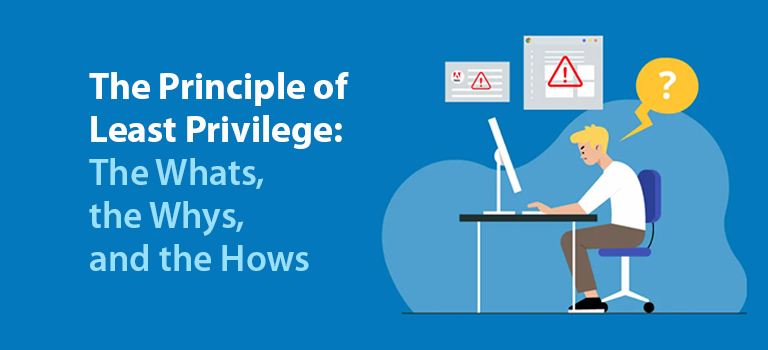According to a recent infographic, in 2020 more than 70% of cybersecurity breaches happened due to the misuse of privileges. This emphasizes the need for the enterprise-wide elimination of unnecessary privileges, which is exactly what the Principle of Least Privilege (PoLP) advocates. Here is a detailed breakdown of what this principle means for organizations and how to implement it:
What is the Principle of Least Privilege (Polp)?
The concept of identifying all privileges in an organization, and removing everything that isn’t essential to business continuity is referred to as the PoLP. It applies to everything, including users, endpoints, applications and other processes. Though widely recognized and acclaimed for its contributions to fortify security, its implementation is tedious and might cause more harm than benefits if applied inadequately.
Why is Implementing This Security Principle Beneficial?
- Vulnerabilities are plentiful in applications, and it is essential to keep them in check. Risks posed by vulnerabilities can be minimized to a large extent by removing unnecessary admin rights, as most can only be successfully exploited with elevated privileges.
- Even if an exploit occurs, malware cannot move laterally in organizations if it has no access to admin rights. The PoLP helps to deter attacks at the point of entry itself, preventing the compromise of entire networks.
- Along with enhancing the security measures of an organization, the PoLP also helps them adhere to various mandatory compliances and regulations.
How to Implement the PoLP
Implementing the PoLP mainly involves two aspects. The first is removing unnecessary admin rights, and the second is having a plan to compensate when user privileges are removed so productivity is not hampered.
Here is a step-by-step guide for evaluating the benefits of PoLP. Utilizing Principle of Least Privilege at your organization enables you to:
- Scan managed endpoints and discover all local admin accounts that are created in each device.
- Analyze and qualify the purpose of each of these accounts and decide which are imperative for the organization.
- Identify admin accounts that are vital for operations, and eliminate any unnecessary admin accounts.
- Construct a list of all the apps that ran previously with admin privileges, and determine if any essential day-to-day activities have been disrupted by eliminating the admin accounts.
- After qualifying the credibility of the user’s need, use a tool that elevates application-specific privileges instead of user-specific privileges.
- Incorporate solutions that cater to temporary needs in the security strategy to ensure that all types of user demands are met.
ManageEngine’s Application Control Plus, an integrated application control and endpoint privilege management solution, lets you implement all of these steps without investing in multiple tools.
The Remove Admin Rights feature of Application Control Plus centrally discovers all the local admin accounts created in your network. This solution lets you automatically remove local admin accounts directly from the console, after excluding the exceptions you require. Application Control Plus also enables you to easily identify and retain built-in admin accounts.
With the Endpoint Privilege Management feature, you can generate a list of apps that were previously run with admin rights. This allows you to make informed decisions about allocating privileges. Create a privileged list of all the apps you deem necessary, and map them only to custom groups of target devices that actually require them. Users with accounts on these devices will be allowed to run these apps as administrators while they continue to remain as standard users.
One-off requests and other interim needs can be handled seamlessly using the Just-in-time (JIT) Access feature which ensures that the privileges are revoked automatically once the need is satisfied.
Application Control Plus provides other features, such as application whitelisting, application blacklisting, flexibility regulator, child process control, that aid in the implementation of the PoLP, and simultaneously let organizations embrace a holistic approach with application security.
Download your free, 30-day trial today!
Ameera Azeez
Tags: AppSec, Cybersecurity, EndpointSecurity, Malware, PoLP, Security, Solutions


